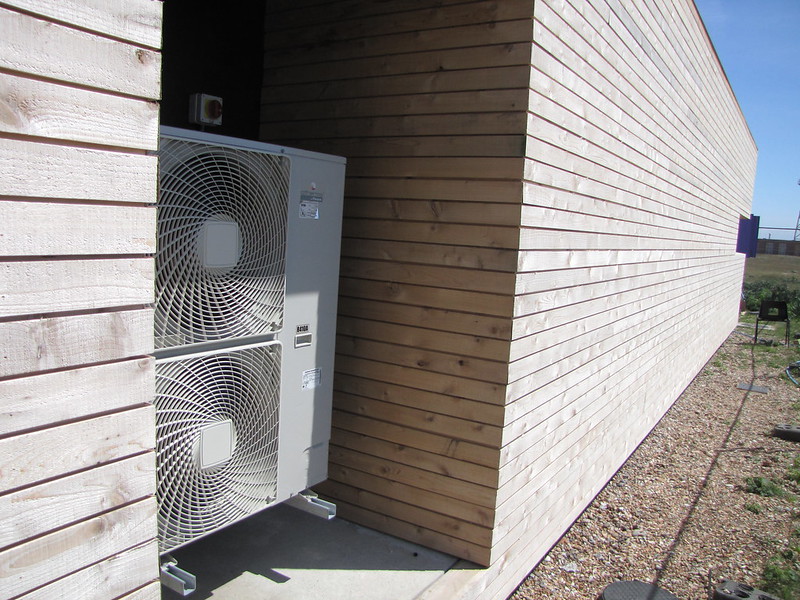Solar panels can indeed run air source heat pumps, and combining the two can lead to significant energy savings and a reduced carbon footprint. However, the specific number of solar panels needed to power an air source heat pump can vary widely based on factors such as the size of the home, local climate, and the heat pump’s efficiency.
Determining the Number of Solar Panels Needed
According to EnergySage, an average home would need between 9 to 13 solar panels to power a whole-house heat pump. However, this number can range from 1 to 42 panels, depending on the home and location. For example, a small, efficient house in San Francisco might only need 1 panel, while a large, drafty house in Minneapolis could require up to 42 panels.
To estimate the number of solar panels needed, one can start by determining the median annual electricity use for a typical heat pump in the U.S., which is about 5,475 kWh per year. This number can vary based on the home’s size, climate, and heat pump specifications. For instance, a heating efficiency of sCOP 2.5 and cooling efficiency of SEER 15 would result in different energy usage levels across different climate zones.
Factors Affecting the Number of Solar Panels
-
Home Size: The size of the home is a crucial factor in determining the number of solar panels needed. Larger homes generally require more energy to heat and cool, necessitating a higher number of solar panels.
-
Climate: The local climate plays a significant role in the energy demands of an air source heat pump. Regions with more extreme temperatures, such as very hot or very cold climates, will require more energy to maintain comfortable indoor conditions, leading to a higher solar panel requirement.
-
Heat Pump Efficiency: The efficiency of the air source heat pump is another important factor. More efficient heat pumps, with higher Seasonal Coefficient of Performance (sCOP) and Seasonal Energy Efficiency Ratio (SEER) ratings, will require fewer solar panels to meet the energy demands.
-
Energy Usage Patterns: The household’s energy usage patterns can also impact the number of solar panels needed. Homes with higher overall energy consumption, such as those with multiple large appliances or high-energy-use activities, will require more solar panels to meet their energy needs.
-
Net Metering and Billing Policies: The local net metering and billing policies can also affect the number of solar panels required. In areas with favorable net metering policies, where excess solar energy can be fed back into the grid and credited to the homeowner’s account, fewer solar panels may be needed to meet the home’s energy demands.
Calculating the Number of Solar Panels
Once the estimated energy usage is determined, one can calculate the number of solar panels needed based on the energy production per panel per year. This calculation should account for any net metering or billing policies that might affect the value of solar energy.
The general formula for calculating the number of solar panels is:
Number of Solar Panels = Annual Energy Consumption / (Solar Panel Wattage × Annual Solar Insolation × Performance Ratio)
Where:
– Annual Energy Consumption is the estimated annual electricity usage of the air source heat pump (in kWh)
– Solar Panel Wattage is the rated power output of the solar panels (in watts)
– Annual Solar Insolation is the average annual solar radiation in the local area (in kWh/m²/year)
– Performance Ratio is a factor that accounts for system losses, typically around 0.75 to 0.85
It’s important to note that this calculation is a rough estimate, and the actual number of solar panels needed may vary based on the specific conditions of the home and the local climate. It’s recommended to consult with a professional solar installer or energy auditor to get a more accurate assessment of the solar panel requirements for your air source heat pump.
Integrating Solar Panels with Air Source Heat Pumps
Once the appropriate number of solar panels has been determined, the next step is to integrate the solar system with the air source heat pump. This process typically involves the following steps:
-
Solar Panel Installation: The solar panels must be installed in a location that maximizes their exposure to sunlight, such as on the roof or in a ground-mounted array.
-
Inverter Selection: An inverter is required to convert the DC electricity generated by the solar panels into AC electricity that can be used by the air source heat pump and the home’s electrical system.
-
Electrical Integration: The solar system must be properly integrated with the home’s electrical system, including the air source heat pump, to ensure seamless operation and energy management.
-
Monitoring and Control: Implementing a monitoring and control system can help optimize the performance of the integrated solar and air source heat pump system, allowing for adjustments and troubleshooting as needed.
-
Maintenance and Upkeep: Regular maintenance and upkeep of both the solar panels and the air source heat pump are essential to maintain optimal performance and efficiency over the long term.
Conclusion
In summary, solar panels can indeed run air source heat pumps, and the combination can lead to significant energy savings and a reduced carbon footprint. However, the specific number of solar panels needed can vary widely based on factors such as the size of the home, local climate, and the heat pump’s efficiency.
By estimating the home’s energy usage and the production capacity of solar panels, one can determine the appropriate number of panels needed to power an air source heat pump. Integrating the solar system with the air source heat pump requires careful planning and execution, but the long-term benefits can be substantial.

